This lemon lavender cake has the perfect balance of flavor between the delicate floral notes of lavender and bright citrus!
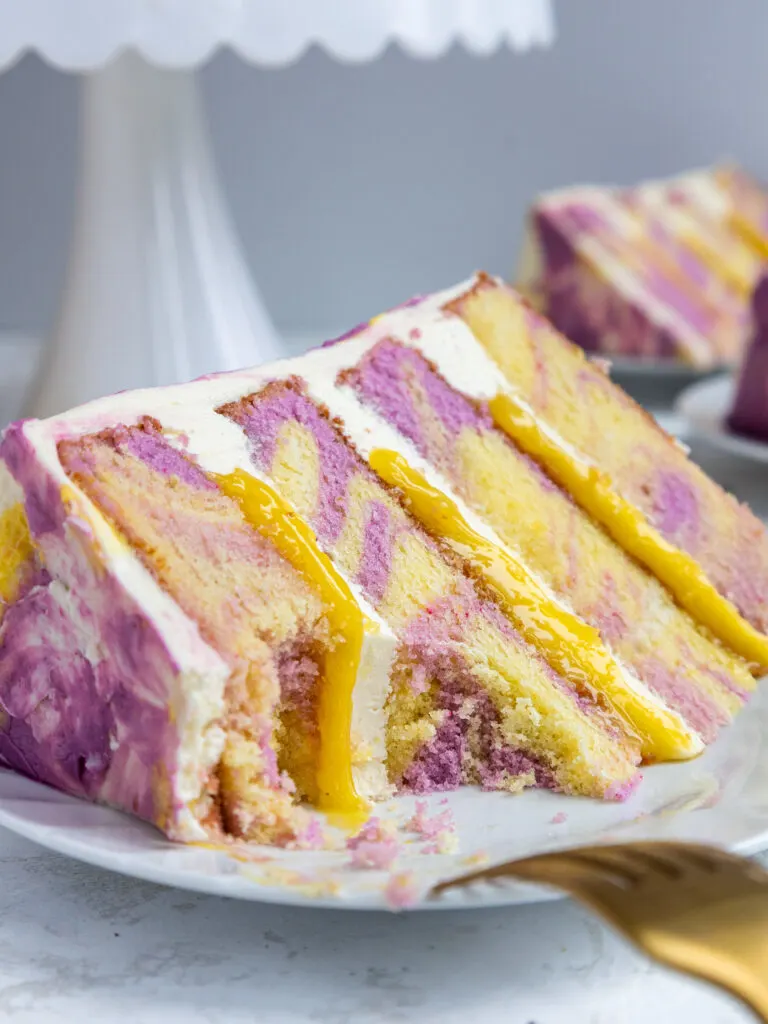
How to Make This Lemon Lavender Cake
To make sure this cake turns out as amazing as possible, let’s walk through each step together! I’ve also included a video tutorial of the process below.
I figured it might be helpful to know what tools I use too, so I’ve shared a list below.
Not all of these are mandatory, but they make the process a lot easier. If you don’t have all these things on hand, feel free to improvise and work with what you have.
- Saucepan
- Fine mesh strainer
- Heat-proof bowl
- 3, 8-inch cake pans or 4, 7-inch cake pans
- Serrated Knife
- Spinning cake stand
- Electric hand mixer or stand mixer
- 10-inch greaseproof cake board
- Large offset spatula
- 1 Large piping bag
Step 1: Make the Lemon Curd
Make the lemon curd first so that it has time to cool and thicken.
I love making lemon curd with this recipe because it helps use up the egg yolks that would be left over after making the Swiss meringue buttercream.
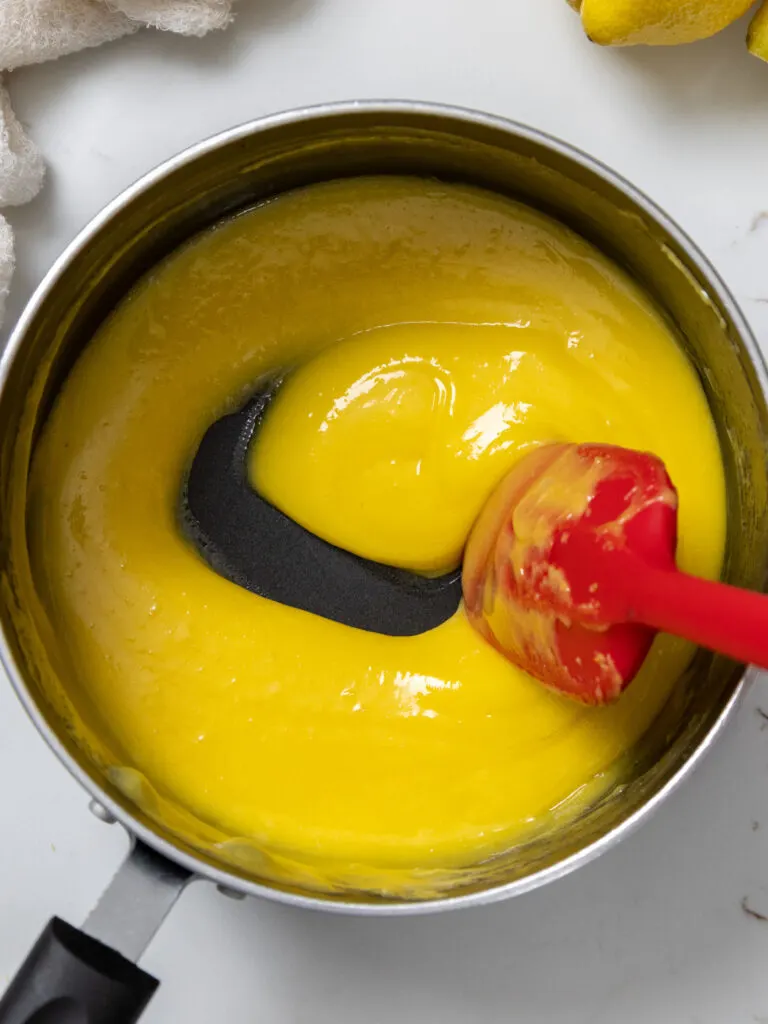
This lemon curd can be made in advance and stored in the fridge for up to a month.
However, if you’re running short on time, you can also use store bought lemon curd.
Step 2: Make the Lavender Milk
Next, we tackle the lavender milk. This step might seem odd, but steeping dried lavender in steamed milk is the best and easiest way to incorporate that delicate floral flavor into our cake layers and buttercream.
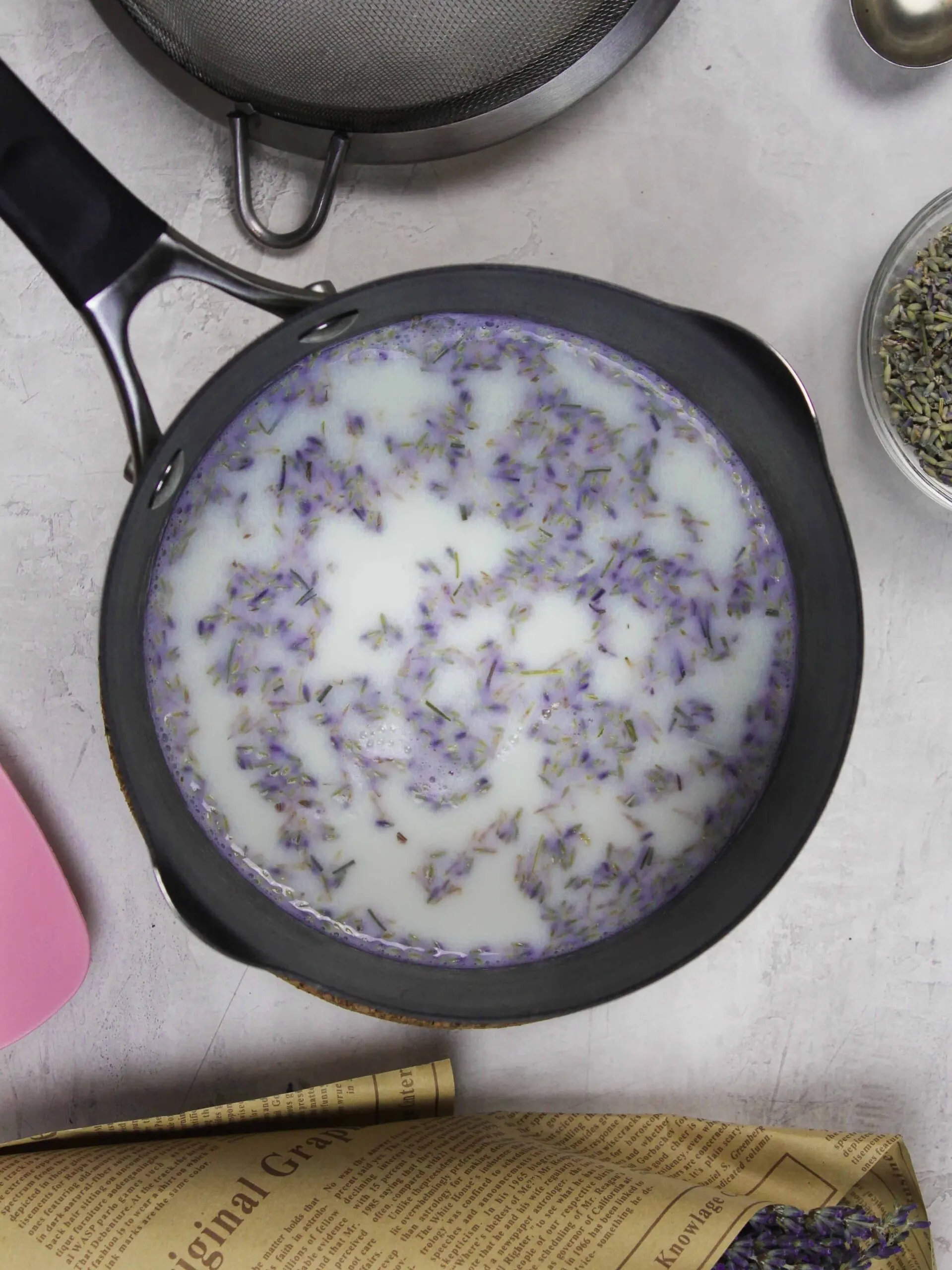
It’s important that you let the lavender steep for 15 minutes to allow the flavor to infuse into the milk.
Step 3: Bake the Lemon Lavender Cake Layers
Then it’s time to make the lemon lavender cake batter following the recipe card at the bottom of this post.
Pour half of the cake batter (about 900g) into a separate bowl. Use a small drop of gel food coloring to color one bowl of batter purple and the other bowl yellow.
Alternate spoonfuls of both colors of batter into the prepared pans. Use a butter knife or a small offset spatula to swirl the batter together.

Bake the layers for 33-36 minutes or until a toothpick comes out with a few moist crumbs.
Remove the cake layers from the oven and let them cool in the pans for about 10 minutes.
Gently run an offset spatula around the rim of the cake pans to loosen them, then flip the cake layers onto wire racks to finish cooling.
Once cooled, use a serrated knife to level the top of each cake layer.
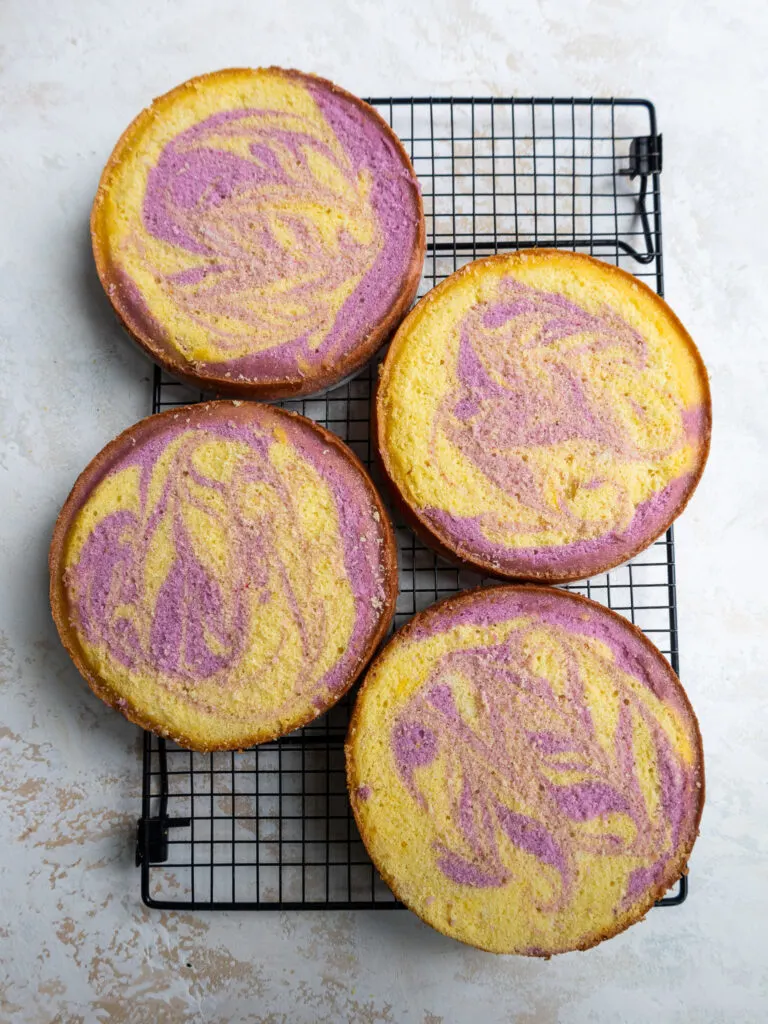
If you’re making these in advance, you can wrap and freeze them at this point.
Step 4: Make the Lavender Frosting
While the cake layers bake and cool, make the lavender frosting.
I like to use my Swiss meringue buttercream (SMBC) as a base, because it isn’t too sweet and really lets the flavors in this buttercream shine through!
Wait to color the frosting until the cake has been filled and frosted.
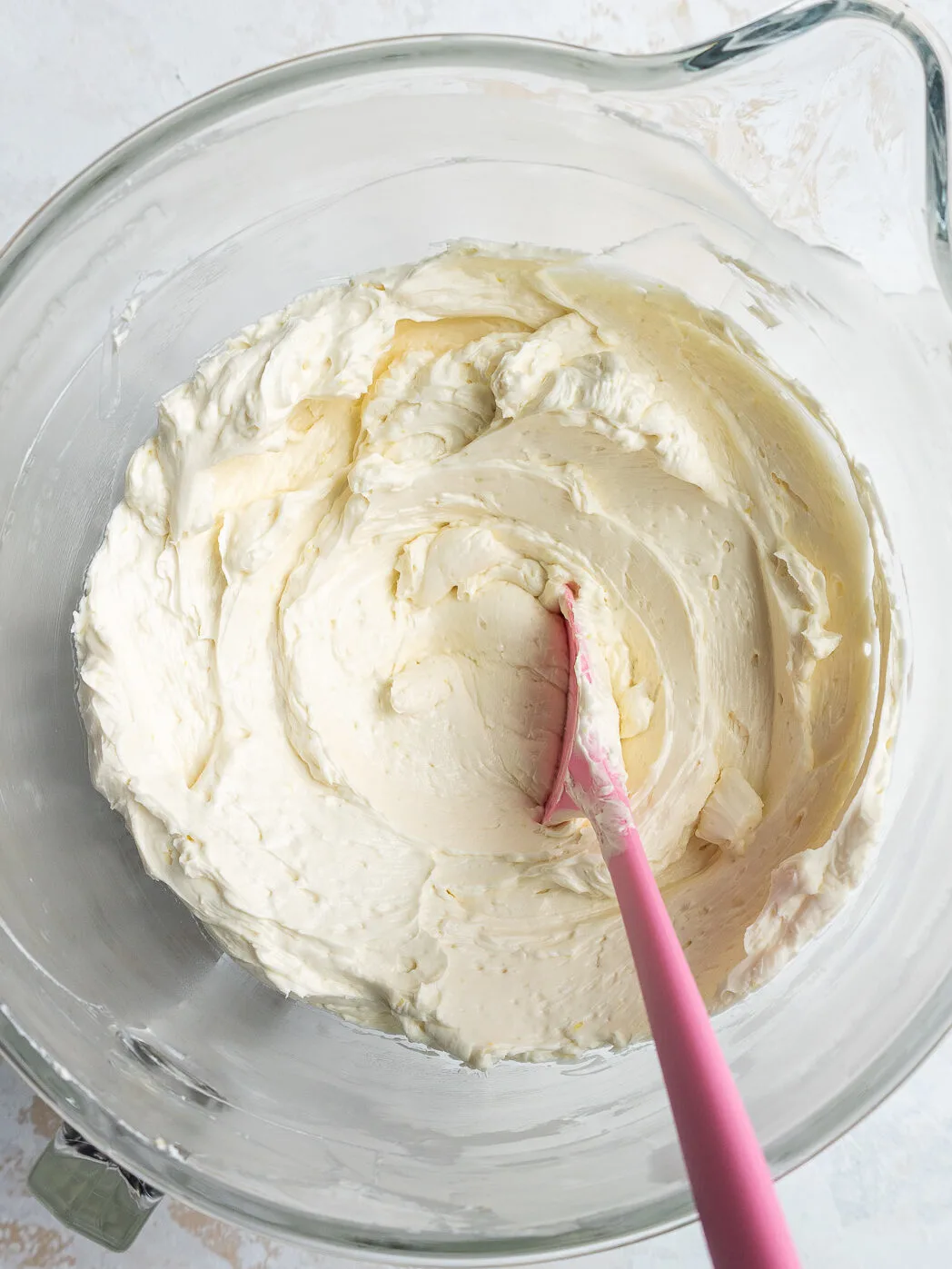
If you aren’t a fan of SMBC, I’d recommend adding the lavender milk to a batch of my American buttercream or 1.5 batches of my hybrid buttercream.
This frosting can also be made in advance if needed and kept in the fridge for up to a month.
Step 5: Stack and Fill the Cake Layers
Then it’s time to assemble this cake! Stack and frost cake layers on a greaseproof cake board or flat plate. Use a dab of buttercream to help stick the first cake layer to the board.
Spread a thin layer of buttercream on top of each cake layer.

Pipe a thick ring of buttercream around the edge of the cake layer and fill the center with lemon curd.
I like to add about 1/2 cup of lemon curd between each layer.
Flip the top cake layer upside down to make it easier to frost and get sharp corners.

Step 6: Chill and Crumb Coat the Cake
Chill the cake in the freezer for 5-10 minutes to prevent the layers from sliding, then add a thin coat of frosting around the cake that fully covers the cake layers.
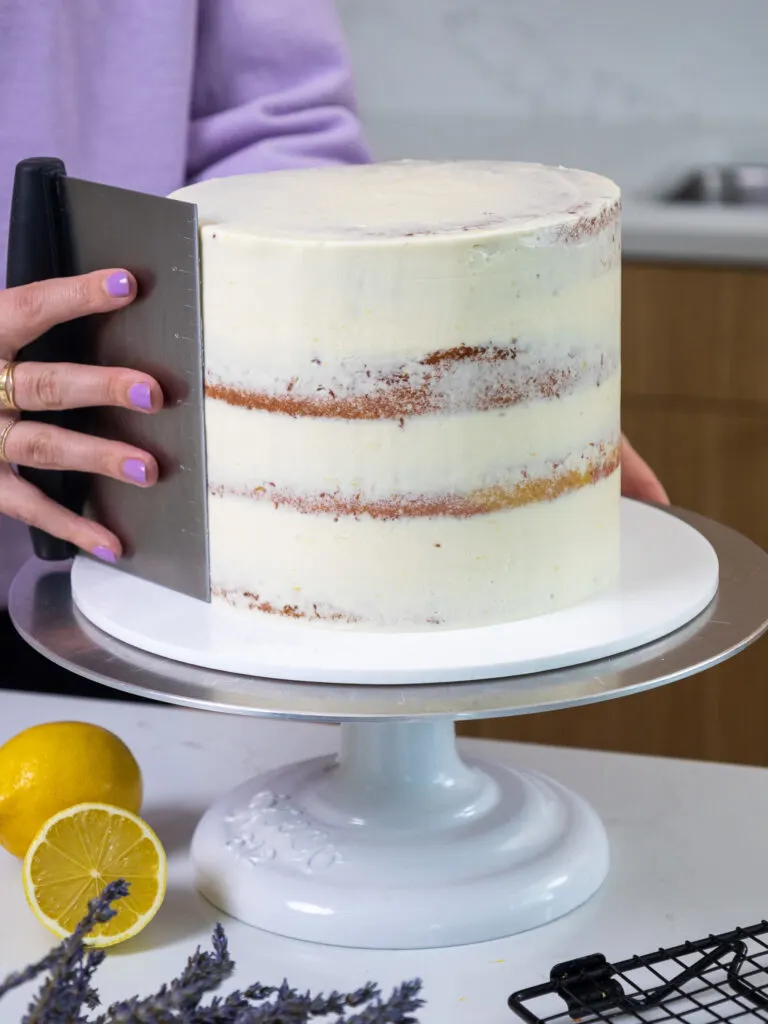
Smooth using a bench scraper, then chill the cake again in the fridge (30 minutes) or freezer (10 minutes) until the frosting is firm to the touch.
Step 7: Add the Second Layer of Frosting & Decorate
Set aside 2/3 cup of frosting, then add a second layer of frosting to the cake with the remaining buttercream. Use a large offset spatula to give the frosting a textured look.
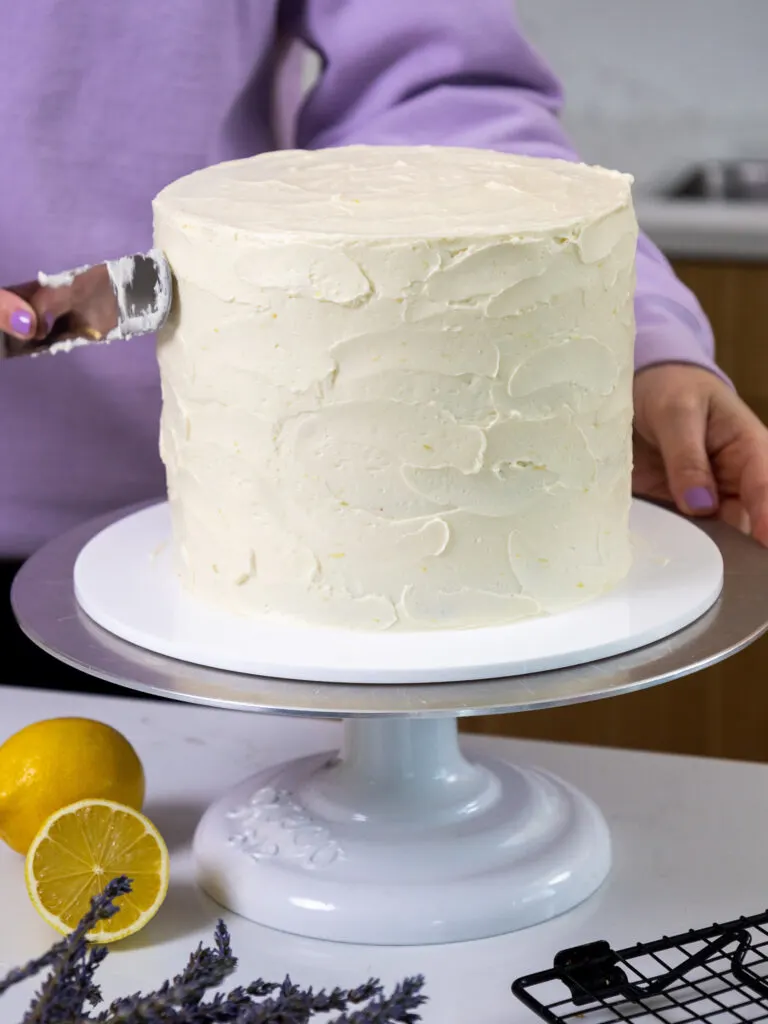
Color half of the reserved frosting yellow, and the other half purple with gel food coloring.
Use a small offset spatula to add colorful swipes of frosting around the cake and blend them into the white frosting. Then enjoy!
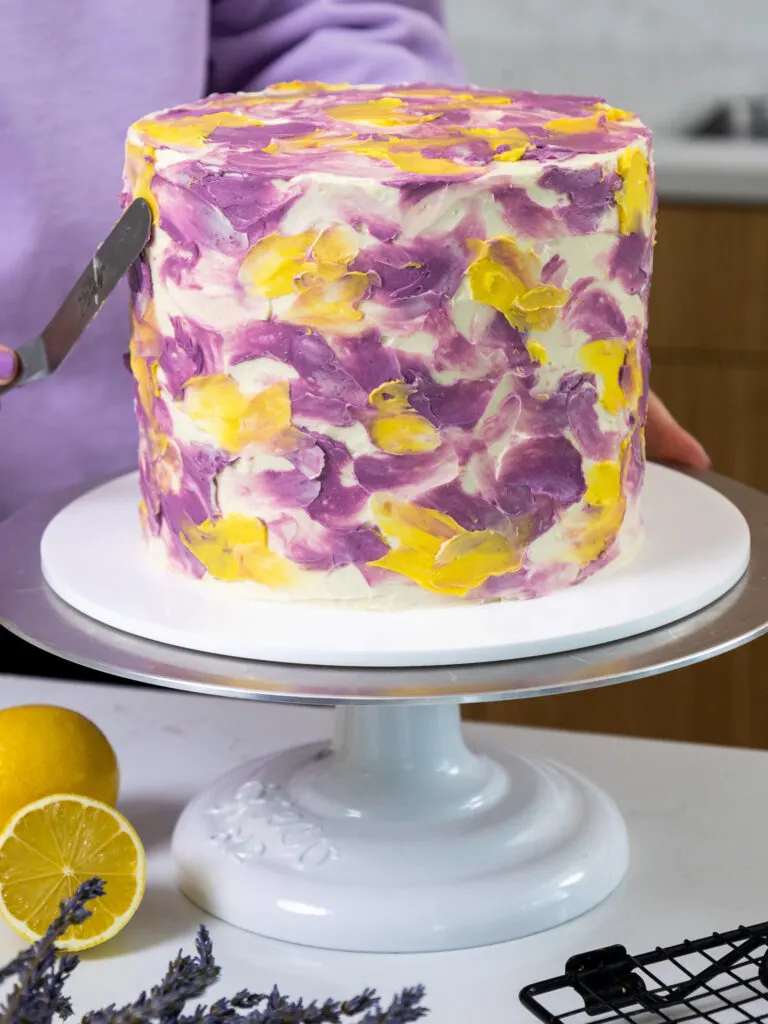
Substitutions and Swaps – Lemon Lavender Cake Layers
This recipe uses quite a few ingredients and I know you might not have them all on hand. Or if you have food allergies or restrictions, I’ve got you covered.
Below are some swaps and substitutions that can be made in this cake recipe.
- Culinary Lavender – I like to use culinary lavender that I order on Amazon in this recipe. You can also find it at some specialty food stores.
- Whole Milk – Skim milk, half and half, or alternative milk can also be used to make the lavender milk.
- Cake Flour – This recipe turns out best with cake flour, but you can use a gluten-free flour blend or all-purpose flour if that’s all you have on hand.
- Granulated Sugar – I do not recommend reducing the amount of sugar because it will change the texture of the cake layers.
- Unsalted Butter – If you only have salted butter on hand, you can use it in place of the unsalted butter in this recipe. Just be sure to omit the salt that this cake recipe calls for. You can also use vegan butter in its place (and also omit the salt)!
- Egg whites – I like to use the pasteurized egg whites that come in a carton, but you can also use 7 fresh egg whites or 4 whole, large eggs. If you have an egg allergy you can try using flaxseed eggs or an egg replacer.
- Sour Cream – You can also use full-fat yogurt, whole milk, or an alternative yogurt or milk (almond, soy, oat) if you’re dairy free.
- Vegetable Oil – You can use any flavorless oil in this recipe. Canola or even sunflower oil would work great!
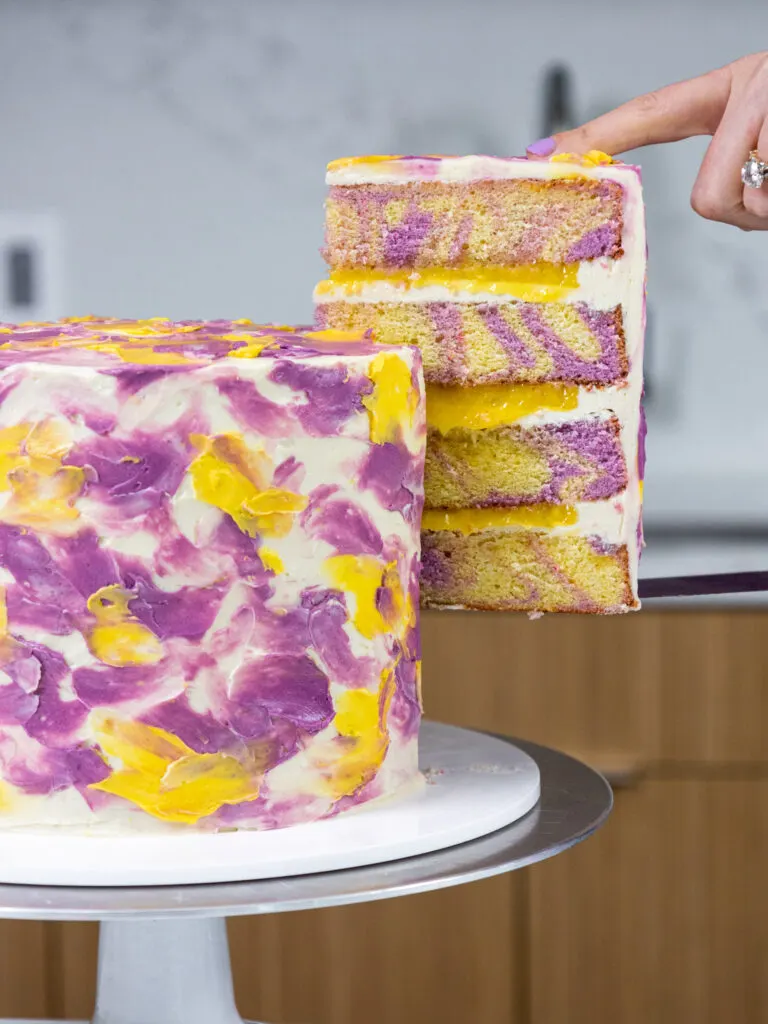
Substitutions and Swaps – Lavender Buttercream
- Unsalted Butter – If you only have salted butter on hand, you can use it in place of the unsalted butter. Just be sure to omit the salt that this frosting recipe calls for. You can also use vegan butter in its place (and omit the salt)!
Making This Cake in Advance and Storage Tips
I highly recommend making the components of this cake in stages. It breaks the process up and makes it so much more approachable!
The lemon curd can be made up to a month in advance and stored in the fridge. Just be sure you save the egg whites to make the Swiss meringue buttercream.
The cake layers can also be made in advance and frozen. They taste just as great when they’re frozen as when they’re fresh, I promise!
You can make the frosting ahead of time or save any leftover frosting! It can be stored in an airtight container in the fridge for up to a month.
Be sure to give it a good stir once it thaws to get the consistency nice and smooth again.
If you cut into the cake and have leftovers, use any remaining frosting to cover the cut section to keep it moist and store it in the fridge for up to a week.

Tips for Making the Best Lavender Lemon Cake
- Let the dried lavender steep in the milk for 15 minutes to give this cake an amazing flavor!
- Properly measure your flour. Either spoon it into the cup measure, then level with a knife or use a kitchen scale to measure your dry ingredients.
- Ingredients at room temp mix together better, so be sure to set out any cold ingredients ahead of time.
- Chill the cake layers in the freezer for about 20 minutes before assembling the cake. This makes them easier to stack and frost.
- Level the room temperature or thawed cake layers with a serrated knife to make them easier to stack and fill.
- Chill the cake before adding on the crumb coat. This will help lock all the lemon curd filling in place and prevent the cake layers from sliding.
- If your cake layers do seem to be sliding, insert a wooden dowel or chopstick through the center of the cake to help keep the layers in place.
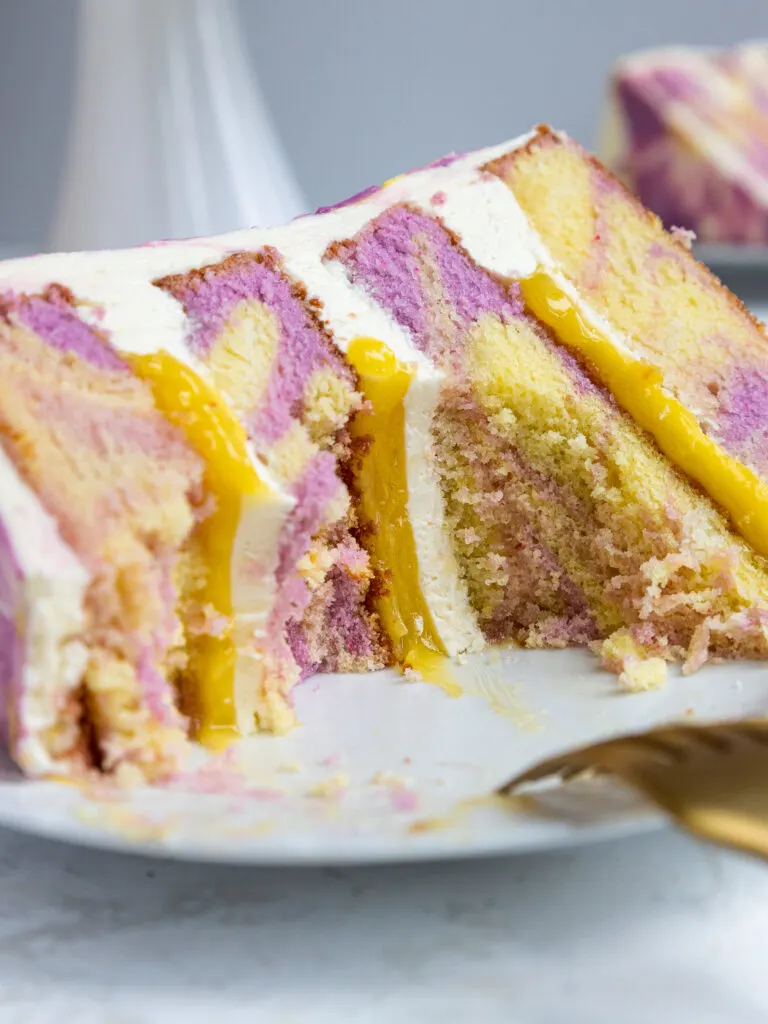
Let Me Know What You Think!
If you make this lemon lavender cake recipe, I’d love to hear what you think of it! Let me know by leaving a rating and comment below.
Tag me @chelsweets and use #chelsweets if you share on social media so that I can see your amazing creations.
Other Recipes You Might Like:
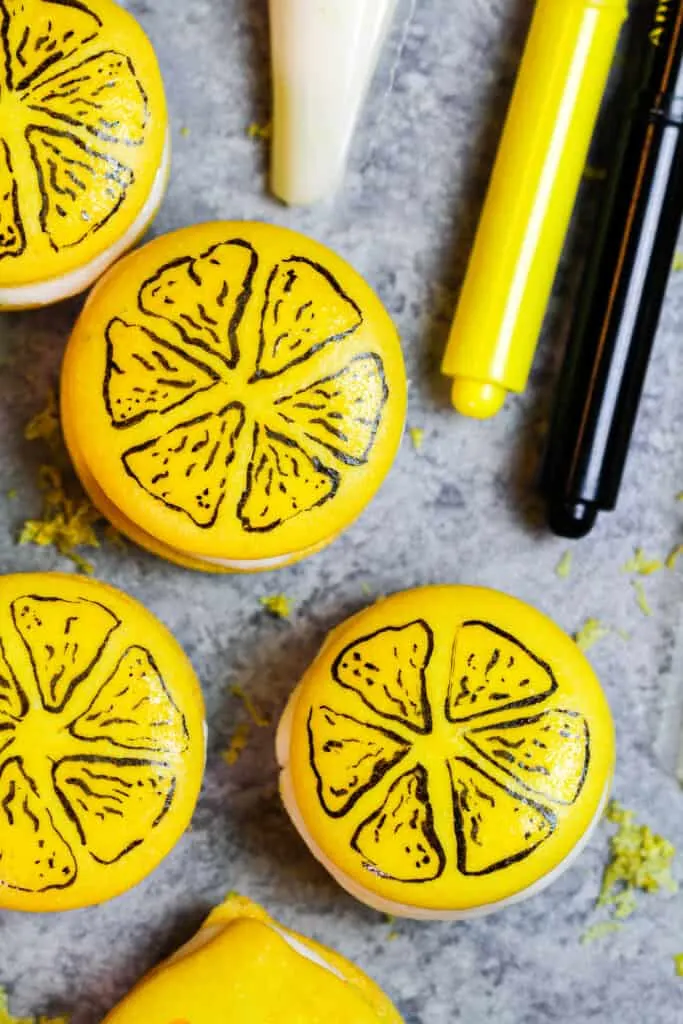

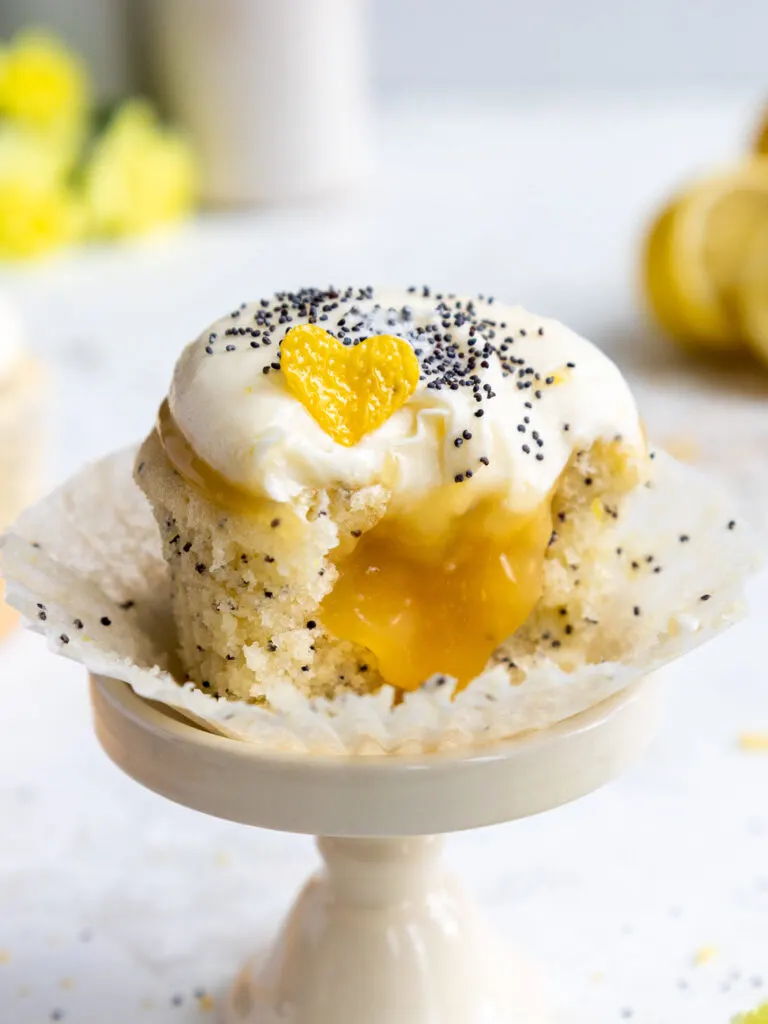
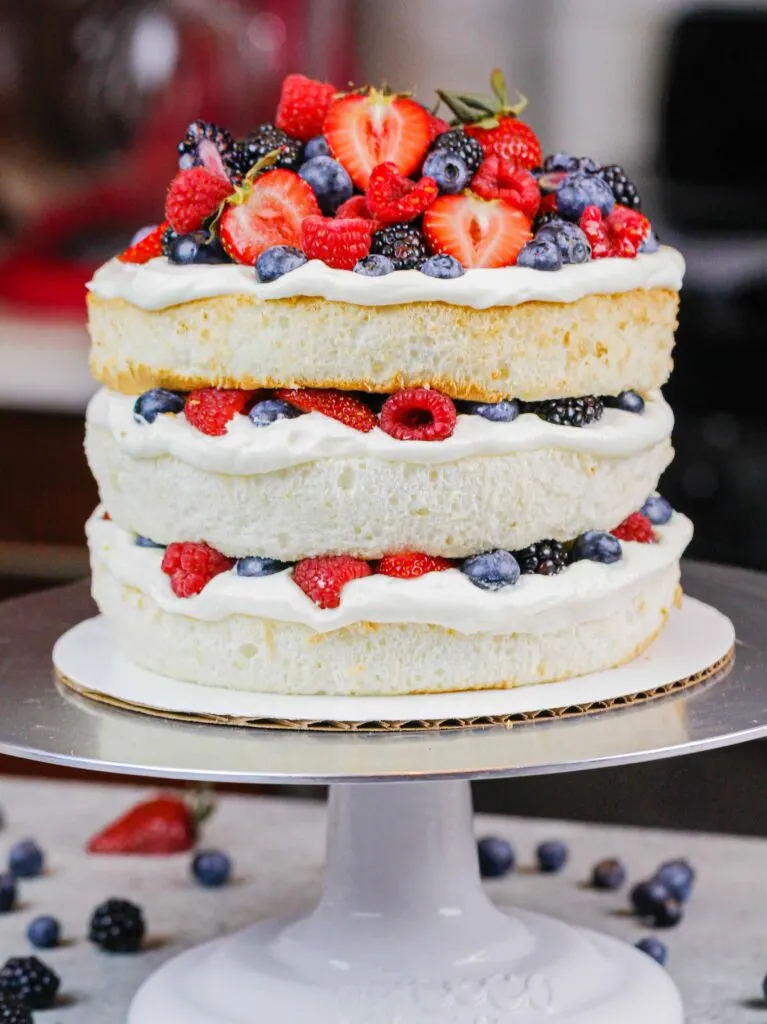
Lemon Lavender Cake
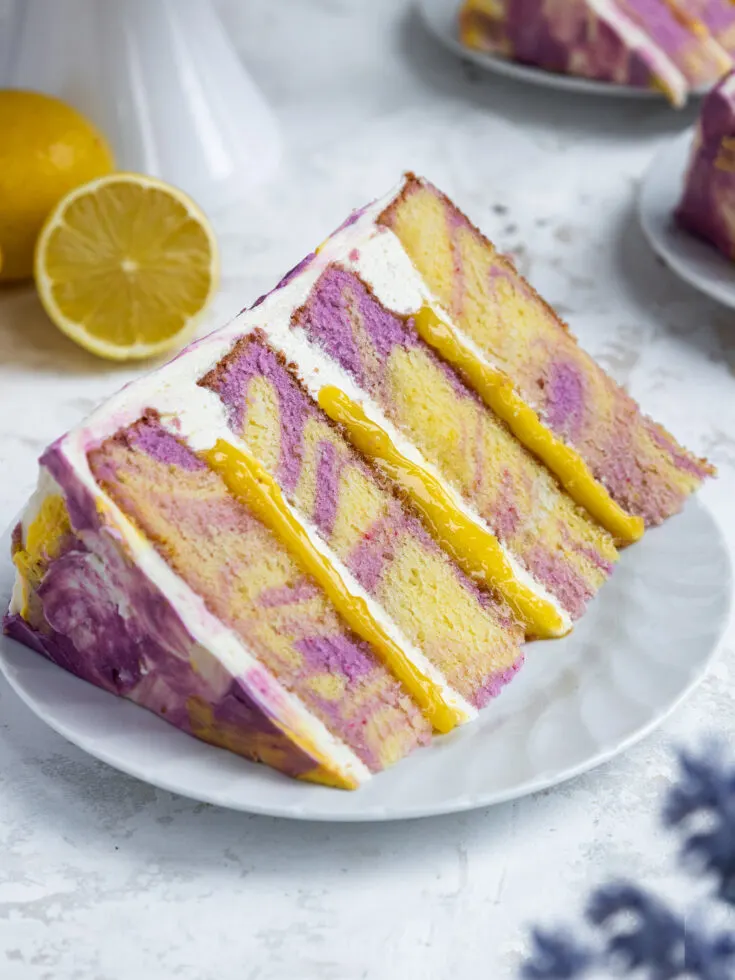
This lemon lavender cake is so delicious and has the perfect balance of flavor between the delicate floral notes of lavender and bright citrus!
Ingredients
Lemon Curd
- 1 cup granulated sugar (200g)
- 2 tbsp lemon zest - zest of 2 large lemons (10g)
- 6 large egg yolks (150g)
- 1/2 cup lemon juice - juice of 2 large lemons (120g)
- 1/2 cup butter unsalted, cold and cut into Tbsp-sized pieces (113g)
Lavender Milk
- 1 cup whole milk, room temperature (240g)
- 3 Tbsp dried culinary lavender (8g)
Lemon Lavender Cake Recipe
- 3 cups granulated sugar (600g)
- 2 Tbsp lemon zest - about 2 large lemons (10g)
- 3 cups cake flour (360g)
- 2 1/2 tsp baking powder (10g)
- 1 tsp fine salt (6g)
- 1 cup (2 sticks) unsalted butter, room temperature (226g)
- 1 cup pasteurized egg whites from a carton or 7 large egg whites, room temperature (240g)
- 1 cup full-fat sour cream, room temperature (250g)
- 1/2 cup of lavender milk - made in recipe above (120g)
- 2 Tbsp vegetable oil (28g)
- 1 tsp vanilla extract (4g)
- purple and yellow gel food coloring (optional)
Lavender Buttercream Frosting
- 8 large egg whites (260g)
- 2 1/2 cups granulated sugar (500g)
- 2 cups (4 sticks) unsalted butter, room temperature (454g)
- 1/4 cup lavender milk, room temperature (60g)
- 2 tsp vanilla extract (8g)
- 1/2 tsp fine salt (3g)
- purple and yellow gel food coloring
Recommend Equipment
Instructions
Lemon Curd
- Make the lemon curd first so that it has time to cool and thicken. Separate 6 yolks from the whites and set aside the egg whites to make the Swiss meringue buttercream later in the process. Make sure the eggs are cold when you separate them; it makes the process easier.
- Add 1 cup of sugar into a small saucepan. Zest 2 lemons into the saucepan and massage the zest into the sugar with your fingertips. This helps release the oil in the zest and gives this curd a bright, citrusy flavor.
- Add in 6 egg yolks and whisk the mixture together until it becomes lighter in color. Then mix in the juice of 2 large lemons (about 1/2 cup).
- Heat on medium-low, stirring constantly with a wire whisk until the mixture thickens and just starts to bubble.
- Remove the pan from heat, then add in 1/2 cup of cold butter that's been cut into smaller pieces. Mix until the butter is fully melted, and the ingredients are combined.
- Pour the lemon curd through a fine mesh strainer into a separate bowl to remove any bits of cooked egg, zest, or lemon seeds. This gives it a perfectly smooth texture! Set aside to cool. If you make the curd in advance, cover it flush with plastic wrap to prevent it from forming a skin and store in the fridge for up to a month.
Lavender Milk
- Next, make the lavender milk. Pour 1 cup of milk into a small saucepan.
- Heat over medium heat until the milk begins to simmer. Remove the pan from the stove top. Add 3 Tbsp dried lavender to the milk.
- Let the mixture steep for 15 minutes, then pour the liquid through a strainer into a small bowl. You should end up with just a little over 3/4 cup (the lavender will absorb some of the milk).
- Set aside to cool before using in the cake batter and frosting.
Lemon Lavender Cake Layers:
- Then it's time for the cake layers! Preheat the oven to 350°F/175°C and line and grease three, 8-inch cake pans or four, 7-inch cake pans with parchment rounds and non-stick spray (I used 7-inch cake pans).
- Add 3 cups sugar and 2 Tbsp lemon zest into a large bowl or the bowl of a stand mixer. Use your fingertips to massage the zest into the sugar to help release the oil in the zest. You should be able to smell the oils being incorporated into the sugar.
- Add 3 cups cake flour, 2 1/2 tsp baking powder, and 1 tsp salt into the bowl with the sugar and whisk together until combined.
- Then mix in 1 cup (2 sticks) of unsalted butter with a paddle attachment or hand mixer on a low speed. Continue to mix until no large chunks of butter remain, and the mixture looks like moist sand.
- Mix in 1 cup of egg whites on a medium speed until incorporated. The batter should be quite thick at this point.
- Then add in 1 cup sour cream, 1/2 cup lavender milk (made in recipe above), 2 Tbsp vegetable oil, and 1 tsp vanilla extract. Mix on a low speed until incorporated.
- Scrape down the sides and bottom of the bowl with a rubber spatula, then beat on a medium speed for about 30 seconds to make sure everything is properly mixed together. This cake recipe uses the reverse creaming method, so this step is important to help give the cake layers a lighter texture.
- Pour half of the cake batter (about 900g) into a separate bowl. Use a small drop of gel food coloring to color one bowl of batter purple and the other bowl yellow.
- Alternate spoonfuls of both colors of batter into the prepared pans. Use a butter knife or a small offset spatula to swirl the batter together. Bake for 33-36 minutes or until a toothpick comes out with a few moist crumbs. Let the cake layers cool in the pans for 10 minutes, then run a small offset spatula around the perimeter of the pan to separate the cake from the pan.
- Flip the cake layers onto a wire rack to cool. Use a serrated knife to level the top of the layers once they're fully cooled.
- If you make these cake layers in advance and freeze them, let them thaw for about 20 minutes before assembling your cake. The cake layers should still be cold to the touch, which will make it easier to assemble your cake.
Lavender Swiss Meringue Frosting:
- While the cake layers bake and cool, make the lavender buttercream frosting.
- Before making the frosting, be sure to thoroughly clean your mixing bowl. If there’s any grease it can make it difficult to whip up the meringue.
- In a medium sized pot, add about 1 inch of water and bring to a simmer.
- Add 8 egg whites (use the 6 egg whites saved from making the lemon curd, plus two additional egg whites) and 2 1/2 cups of granulated sugar into a large metal bowl.
- Place the bowl on top of the pot filled with simmering water. The bowl should create a seal over the pot. Make sure the water isn’t actually touching the bottom of the bowl, or it can cook the egg whites.
- Whisk the mixture constantly for about 3 minutes, until it reaches 160°F / 71°C. You can test the mixture to see if it’s ready by rubbing a tiny bit between your fingertips. The sugar should be fully dissolved, and it should feel super smooth and hot to the touch.
- Lift the bowl away from the pot and dry the bottom with a towel. Pour the mixture into the bowl of a stand mixer and beat on a medium-high speed with a whisk attachment. Mix for about 10 minutes, or until you have stiff, glossy peaks.
- Mix in 2 cups of unsalted butter at a medium speed, 1 stick at a time. Then add in 1/4 cup lavender milk (made in recipe above), 2 tsp vanilla extract, and 1/2 tsp salt and mix on medium until fully incorporated. Scrape the sides and bottom of the bowl with a rubber spatula as needed.
- The frosting should have a thick, whipped consistency at this point. If it looks lumpy or broken, keep mixing until it looks smooth and thick. If it doesn't seem to come together after an additional 10 minutes of mixing, check out my Swiss meringue buttercream troubleshooting guide.
- To make the frosting extra smooth, swap out the whisk attachment for a paddle attachment and continue mixing on a low speed for a couple minutes. Wait to color the frosting until the cake has been filled and frosted.
- Place the frosting in a large piping bag and cut a 1-inch opening at the base of the bag. Set aside.
Assembling this Lemon Lavender Cake:
- Stack and frost cake layers on a greaseproof cake board or flat plate using a dab of frosting to help stick the first cake layer to the board.
- Spread a thin layer of buttercream on top of each cake layer. Pipe a thick ring of buttercream around the edge of the cake layer and fill the center with lemon curd. I like to add about 1/2 cup between each layer. Flip the top cake layer upside down to make it easier to frost and get sharp corners.
- Chill the cake in the freezer for 5-10 minutes to prevent the layers from sliding, then add a thin coat of frosting around the cake that fully covers the cake layers. Smooth using a bench scraper, then chill the cake again in the fridge (30 minutes) or freezer (10 minutes) until the frosting is firm to the touch.
- Set aside 2/3 cup of frosting, then add a second layer of frosting to the cake with the remaining buttercream. Use a large offset spatula to give the frosting a textured look.
- Color half of the reserved frosting yellow, and the other half purple with gel food coloring. Use a small offset spatula to add colorful swipes of frosting around the cake and blend them into the white frosting. Then enjoy!
Notes
Substitutions and Swaps
If you need to make any substitutions or swaps in this recipe, please check out the section on ingredient substitutions in the post above.
Making this Lemon Lavender Layer Cake in Different Sizes
One batch of batter is about 1800g or 10 cups, so I add roughly 600g to each of my cake pans when using 3, 8-inch cake pans, or 450g to my cake pans when using 4, 7-inch cake pans.
You can also use one batch of batter to make 2, 9-inch cake layers or 4, 6-inch cake layers. Bake time will be a few minutes longer at 350 F / 175 C.
If you want to make a tiered cake with this recipe, check out my cake batter calculator to see how many batches of batter you'll need.
If you want to make lemon lavender cupcakes, bake them at 350F / 175C for 18-21 minutes. One batch of batter will make about 3 dozen cupcakes (yield will vary based on the size of your liners).
Or if you just want to make a dozen cupcakes, you can use my lemon lavender cupcake recipe.
Tips for Making the Best Lemon Lavender Layer Cake:
- Let the dried lavender steep in the milk for 15 minutes to give this cake an amazing flavor!
- Properly measure your flour (spoon into the cup measure, then level) or use a kitchen scale to measure your dry ingredients.
- Ingredients at room temperature mix together better. Set out any cold ingredients ahead of time.
- Chill the cake layers in the freezer for about 20 minutes before assembling the cake. This makes it a lot easier to stack and frost.
- Chill the entire cake before adding on the crumb coat. This will help lock all the lemon curd filling in place and prevent the cake layers from sliding.
- If your cake layers do seem to be sliding, insert a wooden dowel or chopstick through the center of the cake to help keep the layers in place.
Making This Cake in Advance and Storage Tips
I highly recommend making the components of this cake in stages. It breaks the process up and makes it so much more approachable!
The lemon curd can be made up to a month in advance and stored in the fridge. Just be sure you save the egg whites to make the Swiss meringue buttercream.
The cake layers can also be made in advance and frozen. They taste just as great when they're frozen as when they're fresh, I promise!
You can make the frosting ahead of time or save any leftover frosting! It can be stored in an airtight container in the fridge for up to a month.
Be sure to give it a good stir once it thaws to get the consistency nice and smooth again.
If you cut into the cake and have leftovers, use any remaining frosting to cover the cut section to keep it moist and store in the fridge for up to a week.
Nutrition Information
Yield
24Serving Size
1Amount Per Serving Calories 526Total Fat 16gSaturated Fat 6gTrans Fat 0gUnsaturated Fat 8gCholesterol 97mgSodium 380mgCarbohydrates 90gFiber 1gSugar 70gProtein 9g

Debbie
Tuesday 15th of August 2023
I am making this cake tomorrow for a friend's birthday and will double your hybrid buttercream (want to make sure I have enough to decorate). Do I increase the lavender milk?
Thanks!
Debbie
Tuesday 22nd of August 2023
I made a dozen cupcakes from this recipe and they turned out great! Thank you for such an amazing recipe!
Debbie
Saturday 19th of August 2023
@Chelsweets, the cake turned out great! My friend loved it. Thank you. I have left over buttercream & want to make cupcakes using this recipe. Can I scale it down by 1/3 to make 12 cupcakes? Thanks again!
Chelsweets
Wednesday 16th of August 2023
Hi Debbie,
Great question! Yes, I've recommend doubling the amount of lavender milk and adding it to a double batch of my hybrid buttercream recipe. Hope that helps and that the cake turns out great! Happy baking!
Lindsay
Friday 16th of June 2023
Hi, I can't source whole lavender, how could I make this recipe work with lavender extract if possible?
Chelsweets
Monday 26th of June 2023
Hi Lindsay,
Great question! Sadly I haven't tested this recipe with lavender extract before, but I'd recommend adding a tsp, then taste testing the frosting/cake batter and adjusting as need if you want a stronger flavor. Hope that helps, happy baking!
Magda
Monday 15th of May 2023
Hi Chels, can I frost this cake with the classic italian meringue buttercream?
Chelsweets
Sunday 21st of May 2023
Hi Magda,
You totally can frost this cake with a classic Italian meringue buttercream :) That would be delicious!!
Lemon Curd Cake: Delicious Recipe from Scratch
Thursday 27th of April 2023
[…] Lemon Lavender Cake Lemon Poppy Seed Cupcakes Earl Grey Lavender Cake Lemon Meringue Macarons […]
Julia
Friday 14th of April 2023
I made this recipe into a cupcake version (it made exactly 3 dozen, baked at 350 for 18 min) and placed the lemon curd in the middle of each cupcake. It turned out delicious! This recipe is phenomenal and I’ll definitely be making it again! I look forward to making this as the intended cake version in the future :)
Chelsweets
Sunday 16th of April 2023
Hi Julia,
So happy to hear that!! Thank you so much for sharing :) Happy baking!!